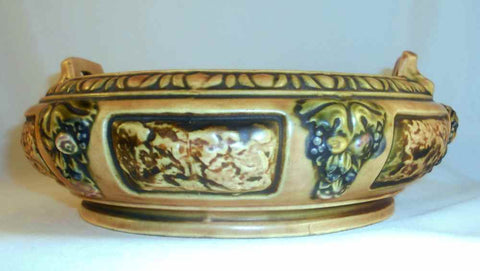Mulberry Transfer Ware Ironstone Plate J. Meir & Son Pottery Staffordshire Roselle Pattern
Description: Antique mulberry transfer ware or transferware plate made by the John Meir and Son Pottery of Tunstall of Stoke-on-Trent. It is in the Ironstone Roselle pattern. The plate has a central scene with a house on the edge of a water body, having steps leading to the water, with other houses or buildings in the distance, all of which have towering structures. The buildings which are all on the edge of the water are surrounded by trees and vegetation. The edge of the plate has a nice design depicting a flower basket with large flowers and foliage repeating throughout and surrounded by a nice geometrical design. The plate has a plain rounded rim. The plate is marked with an impressed and a transfer Type A pottery English registry mark, which dates it from 1848. Please carefully review the photos as they are part and parcel of our description.
Date: November 26, 1848.
Origin: Tunstall, Staffordshire, England.
Size: Measures 10" in diameter, 1 3/16" in height and weighs almost 1 1/2 pounds.
Maker: John Meir & Son Pottery (operated in the period 1837 through 1897).
Marks: Transfer of a Type "A" English registry mark on the bottom of the plate which dates the plate as being from November 26, 1848 with the words "Roselle; J. Meir & Son" under it and the word "ironstone" with a crown under it above it. there is also an impressed mark indicating the piece is a Memnon Shape made by J Meir & Son on and a type A registry mark which is not very clear.
Distinguishing Characteristics - Most Interesting About The Piece: Very nice pattern by a well known pottery from the Stoke-on-Trent area.
Condition: Plate is in excellent condition with no cracks, hairlines, discoloration, or repairs. It has general crazing to the glaze. It has three small spots within the rim in the front where the glaze is missing suggesting that the plate was fired with the front resting on a three pronged triangle so it would not touch the shelf. It also has three spots on the back with missing glaze, where the plate rested on three small triangular stands during a second firing. All of these issues are original to the making of the plate and are common with this type of Ironstone ware made in Staffordshire in the mid 19th century. Finally, the plate has some of the usual defects you would expect in Staffordshire transferware from the era such as pops, slubs, and areas where the transfer did not cover entirely. This particular plate has very few of those issues and is a great specimen. Please see photos to appreciate the beauty and condition of this piece.
In Closing: Just a very nice piece with bold and fresh colors in great condition after being around for over 160 years. This would make a great addition to your collection of Staffordshire pottery.











